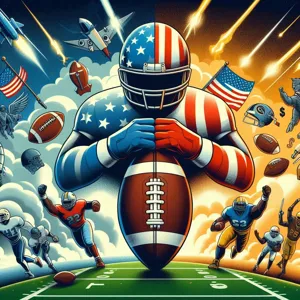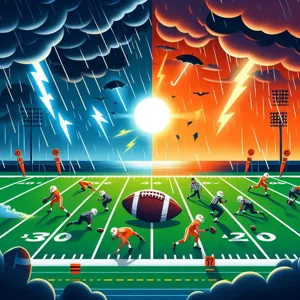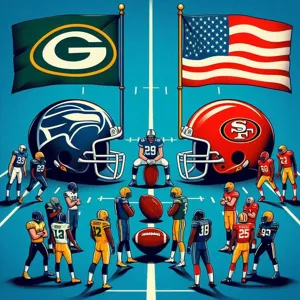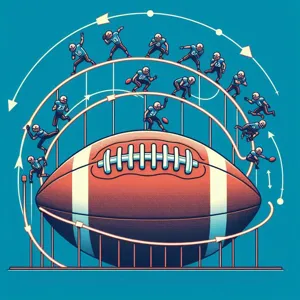Soccer, often hailed as the beautiful game, is more than just a sport; it is a complex tapestry woven from strategy, skill, and sheer passion.
While fans worldwide celebrate the thrilling goals and spectacular saves, the true essence of success in soccer lies in the subtleties that often go unnoticed. From the intricate interplay of tactics executed on the pitch to the mental fortitude required to overcome adversity, every match is a showcase of countless elements that work in tandem to determine the outcome. In this blog post, we will delve into the key aspects that define soccer success, exploring the significance of teamwork, the impact of coaching strategies, the role of player psychology, and much more. Join us as we uncover the game within the game and gain a deeper appreciation for the nuances that elevate this beloved sport to extraordinary heights.
1. Introduction: Understanding the Game Within the Game

Soccer, often dubbed the beautiful game, is a sport that captivates millions around the globe with its blend of skill, strategy, and sheer athleticism. However, beneath the surface of thrilling goals and nail-biting matches lies a complex tapestry of tactics and psychology that defines true success on the field. This is what we refer to as “the game within the game.”
At its core, soccer is more than just a contest of physical prowess; it is a mental chess match where players and coaches must constantly adapt to the ebb and flow of the game. Understanding formations, player roles, and strategic maneuvers can elevate a team’s performance from mediocre to extraordinary. It’s about reading the opponent, anticipating their moves, and executing counter-strategies with precision.
Moreover, the psychological aspect cannot be overlooked. The ability to maintain composure under pressure, foster a strong team dynamic, and cultivate a winning mindset are crucial elements that can make or break a season. The most successful teams are those that harmonize individual talents with collective effort, creating a synergy that is difficult for opponents to counteract.
In this blog post, we will delve deeper into these key aspects that define success in soccer. From tactical intelligence to psychological resilience, we’ll explore the nuances that separate the great teams from the good ones, illuminating the intricate game that unfolds each time the whistle blows. Join us as we uncover the layers of strategy and mental fortitude that truly shape the outcome of the matches we love.
2. The Role of Tactical Awareness
Tactical awareness is a cornerstone of success in soccer, serving as the invisible conductor that orchestrates the flow of the game. It encompasses a player’s understanding of their position, the movements of teammates and opponents, and the overall strategy dictated by the coach. A player with high tactical awareness can read the game like a seasoned chess player, anticipating moves and adjusting their strategy accordingly.
Consider the midfielder, often viewed as the heartbeat of the team. Their ability to observe the positioning of both allies and adversaries enables them to make split-second decisions that can alter the course of the match. Should they play a quick pass to exploit a gap in the defense, or hold the ball to draw out an opponent? The answer hinges on their tactical insight.
Moreover, tactical awareness extends beyond individual performance; it’s about understanding the collective dynamics of the team. Players must be attuned to the team’s formation and the roles each player fulfills within it. For instance, when a full-back makes an overlapping run, a winger with strong tactical awareness should recognize this opportunity and adjust their positioning to either create space or support the attack.
The beauty of tactical awareness lies in its adaptability. Different opponents present unique challenges, and a team that can adjust its tactics in real-time is often the one that prevails. Coaches play a pivotal role in this aspect, as they analyze opposition strengths and weaknesses, devising game plans that players must internalize.
In essence, the ability to think critically and react swiftly is what separates good players from great ones. Those who master the art of tactical awareness not only enhance their own performance but elevate the entire team’s game, contributing to a cohesive unit that can navigate the complexities of soccer with finesse and success.
3. Importance of Mental Resilience

In the world of soccer, where physical prowess and tactical acumen often take center stage, the importance of mental resilience cannot be overstated. It’s the silent force that can make the difference between a good player and a great one, and it plays a crucial role in determining the success of a team. Mental resilience is the ability to bounce back from setbacks, maintain focus under pressure, and stay committed to the game plan, regardless of the circumstances.
Consider the pressure cooker of a penalty shootout, where the weight of the match rests on the shoulders of the players. It’s not merely the skill of kicking the ball that counts; it’s the mental fortitude to handle the high stakes and the eyes of thousands watching. Players must cultivate a strong mindset to conquer their fears, silence self-doubt, and channel their emotions into positive performance.
Moreover, soccer is replete with challenges—from injuries and defeats to the relentless grind of a season. Resilient players are those who can embrace these challenges as opportunities for growth. They learn to view a missed goal or a lost match not as an end, but as a stepping stone toward improvement. Coaches and sports psychologists often emphasize the importance of mental training, incorporating techniques such as visualization, mindfulness, and positive self-talk to help players build their mental toughness.
Teams that foster a culture of resilience tend to rise above adversity. They support each other, share a collective belief in their abilities, and maintain an unwavering focus on their goals. This mental strength translates into on-field synergy, where players instinctively trust one another during high-pressure moments. In the end, while talent and technique are undeniably important, it is mental resilience that sets apart the champions from the rest. It’s this inner game, often invisible to the spectators, that truly defines soccer success.
4. Physical Conditioning and Injury Prevention
In soccer, physical conditioning and injury prevention are not just supplementary aspects of training; they are foundational pillars that can make or break a player’s career and a team’s success. The intense demands of the game require athletes to be in peak physical condition, capable of enduring the rigors of sprinting, sudden changes in direction, and prolonged periods of high-intensity play. This level of conditioning goes beyond mere strength and endurance; it encompasses agility, flexibility, and cardiovascular fitness, all of which are crucial for performance on the pitch.
A well-rounded physical conditioning program incorporates various elements, including strength training, aerobic conditioning, and plyometrics. Strength training enhances muscle power, allowing players to tackle with greater force and jump higher to win headers. Aerobic conditioning builds stamina, enabling athletes to maintain their performance levels throughout the match, while plyometric exercises improve explosive movements essential for quick sprints and sharp turns.
However, conditioning alone is not enough. Injury prevention must be woven into the fabric of every training regimen. Soccer players are particularly susceptible to injuries, from sprained ankles to torn ligaments, often due to the high-impact nature of the sport. Implementing a comprehensive injury prevention strategy can significantly reduce these risks. This includes proper warm-up routines that prepare the body for intense activity, cooldown sessions that facilitate recovery, and regular flexibility training to enhance range of motion and reduce muscle stiffness.
Moreover, players should be educated on the importance of listening to their bodies. Recognizing the early signs of fatigue or discomfort can prevent more serious injuries down the line. Coaches and trainers play a critical role in this aspect, ensuring that training loads are appropriate and that players receive adequate rest and recovery between sessions.
Ultimately, the synergy between physical conditioning and injury prevention sets the stage for long-term success in soccer. A fit and healthy squad not only performs better but also maintains morale and cohesion, ensuring that they can compete at the highest level throughout the season. When players are physically prepared and safeguarded against injuries, they can focus on what truly matters: the beautiful game.
5. Technical Skills: Mastering Ball Control and Passing

In the realm of soccer, technical skills serve as the foundation upon which all other aspects of the game are built. Mastering ball control and passing is not merely a necessity; it is an art form that can define a player’s effectiveness and elevate a team’s performance.
Ball control is the gateway to success on the pitch. The ability to deftly receive, trap, and manipulate the ball allows players to maintain possession and dictate the flow of the game. Whether it’s a perfectly executed first touch that sets up a powerful strike on goal or a subtle flick that allows for a swift change of direction, exceptional ball control transforms a player into a dynamic force. This skill not only involves the feet but also encompasses the body—using thighs, chest, and even shoulders to expertly manage the ball’s movement.
Equally essential is the art of passing. Effective passing is the lifeline of team play, enabling players to work in harmony and create scoring opportunities. A well-placed pass can slice through opposing defenses, while a misjudged one can lead to turnovers and lost momentum. Mastering various types of passes—be it the short, quick flicks that keep the ball moving or the long, sweeping balls that change the angle of attack—allows players to make intelligent decisions under pressure.
Moreover, combining ball control with passing skills fosters a deeper understanding of spatial awareness. Players learn to read the game, anticipate the movements of teammates and opponents, and make split-second decisions that can turn the tide of a match. Training sessions focused on drills that enhance these technical abilities are vital, as they cultivate muscle memory and improve confidence on the ball.
Ultimately, mastering ball control and passing is akin to learning the language of soccer. It empowers players to express themselves creatively on the field, forge connections with teammates, and execute complex plays that leave spectators in awe. In a game where every touch counts, these technical skills are not just advantageous; they are essential for achieving soccer success.
6. The Significance of Team Chemistry
In the world of soccer, skill and strategy are essential, but the true alchemy of success often lies in an intangible element: team chemistry. When players harmonize, a unique synergy emerges that elevates their collective performance beyond the sum of their individual talents. Team chemistry is not merely about knowing where to pass the ball or how to position oneself on the pitch; it’s about understanding your teammates on a deeper level, fostering trust, and building relationships that transcend the game.
Imagine a well-oiled machine, each cog moving in perfect synchronization. This is what effective team chemistry looks like on the field. Players who share a strong rapport can anticipate each other’s movements, making split-second decisions that can turn the tide of a match. This intuitive understanding can be the difference between a beautiful goal and a missed opportunity. For instance, a striker who knows his forward’s playing style can position himself perfectly for a pass, while a midfielder with a deep understanding of his teammates’ strengths can create openings and deliver the ball with precision.
Moreover, team chemistry fosters a supportive environment where players feel valued and motivated. It cultivates camaraderie, leading to improved communication and collaboration during crucial moments of play. Teams with strong chemistry often display resilience; they bounce back from setbacks together, drawing on their shared experiences to overcome challenges. This sense of unity can be particularly crucial during high-pressure matches, where mental fortitude is just as important as physical skill.
Building team chemistry is an ongoing process that requires time, effort, and intentionality. Coaches play a vital role in this development, creating opportunities for team bonding both on and off the field. Activities such as team-building exercises, social events, and open discussions can help strengthen relationships and foster a culture of trust. Ultimately, the significance of team chemistry cannot be overstated; it is the heartbeat of successful soccer teams, driving them toward victory and creating memories that last a lifetime.
7. Analyzing Opponent Strategies

Analyzing opponent strategies is a crucial component of achieving success on the soccer field. Understanding how your rivals play can be the difference between victory and defeat. To gain a competitive edge, teams must delve deep into the tactical nuances of their opponents, studying their formations, playing style, and key players. This often involves watching match footage, breaking down game statistics, and even employing advanced analytics to identify trends and weaknesses.
Every team has its own unique style—some prefer a high-pressing game that forces mistakes, while others might adopt a more defensive posture, relying on counter-attacks to capitalize on opportunities. By meticulously analyzing these strategies, coaches and players can devise tailored game plans that exploit the opponent’s vulnerabilities. For instance, if a rival has a tendency to leave gaps in their defense when transitioning from attack to defense, your team can train specifically to exploit those spaces, creating scoring opportunities.
Moreover, this analysis goes beyond just their tactical approach; it also includes understanding the psychological elements at play. Identifying how opponents respond under pressure, their reactions to adversity, and even their emotional triggers can provide invaluable insights. Soccer is as much a mental game as it is a physical one, and knowing when to apply pressure or when to hold back can shift the momentum of a match.
In today’s game, where technology plays a pivotal role, teams are employing data analytics platforms and video analysis software to enhance their preparation. This allows for in-depth breakdowns of not only direct opponents but also future competition, creating a robust strategy that adapts to evolving circumstances. By continuously analyzing and anticipating opponent strategies, teams can position themselves not just to compete but to dominate, embodying the essence of proactive gameplay that leads to success on the pitch.
8. Effective Communication on the Field
Effective communication on the field is the backbone of any successful soccer team. It transcends mere verbal exchanges; it’s a symphony of gestures, eye contact, and body language that orchestrates the rhythm of play. In the heat of the moment, when the stakes are high and the crowd roars, the ability to communicate effectively can mean the difference between victory and defeat.
Imagine a midfielder, poised to deliver a crucial pass. With a quick glance and a subtle nod, they signal to a forward making a darting run. This non-verbal cue not only enhances understanding but also fosters trust among teammates. It’s these split-second decisions, fueled by effective communication, that can unravel even the most formidable defenses.
Moreover, effective communication extends beyond the immediate play. It involves players constantly providing feedback, whether it’s a defender calling for support during a counter-attack or a goalkeeper directing traffic during a corner kick. Clear and assertive communication helps maintain shape, ensures everyone knows their roles, and facilitates seamless transitions between offensive and defensive phases of the game.
On a tactical level, coaches must also play their part. During training sessions, emphasizing communication drills can help cultivate a culture where players feel comfortable expressing themselves on the field. Encouraging open dialogue allows players to voice their thoughts, fostering a more cohesive unit that can adapt to the game’s dynamic nature.
Ultimately, effective communication is about building relationships and understanding among players. When each member of the team is attuned to their teammates’ movements and intentions, they can work in harmony to execute complex strategies and exploit the weaknesses of their opponents. In soccer, as in life, the ability to communicate effectively can elevate a team from mediocrity to greatness.
9. The Impact of Coaching Styles
Coaching styles play a pivotal role in shaping the dynamics of a soccer team and can significantly influence a player’s development, team cohesion, and overall success on the field. Each coach brings a unique philosophy to the game, whether it’s a focus on tactical discipline, player development, or a more free-flowing, creative approach. Understanding these varied coaching styles can illuminate how they impact players’ performance and the team’s results.
For instance, a coach who emphasizes a possession-based game fosters a culture where players are encouraged to maintain control of the ball, make intelligent passes, and utilize space effectively. This style not only enhances teamwork but also demands a higher level of technical skill from each player. On the other hand, a coach who adopts a counter-attacking strategy may prioritize speed and agility, training players to recognize and exploit defensive vulnerabilities quickly. Such a style can lead to exhilarating matches, but it requires players to be exceptionally adaptable and strategic in their movements.
Moreover, the emotional intelligence of a coach cannot be overlooked. A coach who fosters a supportive environment, encourages communication, and builds trust can dramatically enhance team morale. By understanding individual players’ strengths and weaknesses, a coach can tailor their approach, ensuring that each player feels valued and motivated. This personalized attention often translates to improved performance on the pitch, as players are more likely to give their all when they feel their contributions are recognized and appreciated.
Ultimately, the impact of coaching styles extends beyond tactics and formations; it shapes the culture of the team. A strong leader can cultivate resilience, instill a winning mentality, and inspire players to overcome challenges. As teams strive for success, the influence of a coach’s philosophy becomes a defining factor in their journey, illustrating that in soccer, as in life, the right guidance can make all the difference.
10. Adapting to Game Situations
In the high-stakes world of soccer, adaptability is not just a skill; it’s a necessity. On the pitch, the dynamics can shift in an instant—an opponent’s strategy may change, a key player might get injured, or the weather could affect the playing conditions. Successful teams are those that can read the game, anticipate changes, and adjust their tactics accordingly.
Adapting to game situations involves a deep understanding of both the game itself and the players on the field. Coaches and players must be on the same page, utilizing real-time communication to make swift decisions. For instance, if the opposing team adopts a more aggressive formation, a team may choose to tighten its defense, switch to a counter-attacking strategy, or bring in a fresh substitute to inject energy into the game. This flexibility can make all the difference between securing a win or facing defeat.
Moreover, adaptability extends beyond tactical changes; it also encompasses the mental and emotional aspects of the game. Players must maintain composure and resilience in the face of adversity, whether it’s a last-minute goal against them or a missed penalty kick. Champions are often defined by their ability to regroup, refocus, and execute their game plan under pressure.
In practice, this means developing a versatile squad where players are not confined to specific roles but are encouraged to be multi-faceted. Training sessions should incorporate scenarios that simulate various game situations, allowing players to practice their decision-making skills in a controlled environment. The more prepared they are to handle uncertainty, the more successful they will be when it truly matters on the field.
Ultimately, adaptability in soccer is about more than just reacting to the game; it’s about anticipating the ebb and flow of play, making proactive adjustments, and fostering a mindset that thrives on challenge. In a game defined by split-second decisions, those who can pivot seamlessly will often find themselves with the edge—turning potential setbacks into opportunities for triumph.
11. Set Pieces: A Tactical Advantage
In the world of soccer, the significance of set pieces cannot be overstated. These moments, whether from free kicks, corner kicks, or throw-ins, present a golden opportunity for teams to exploit the opposition’s defensive weaknesses while showcasing their tactical acumen. Mastering set pieces can often tip the scales in closely contested matches, transforming a seemingly ordinary game into a thrilling display of strategy and skill.
The art of a successful set piece begins with meticulous planning and practice. Coaches dedicate countless hours to devising innovative routines that can catch the opposing defense off-guard. This involves studying the opposition’s tendencies, identifying gaps in their setup, and designing plays that can exploit these vulnerabilities. A well-executed free kick, for instance, can either result in a direct goal or create chaos in the penalty area, allowing teammates to capitalize on the confusion.
Players must also develop a keen understanding of their roles during set pieces. The designated taker needs to possess precision and composure, whether they are delivering a curling ball into the box or striking a powerful shot at goal. Meanwhile, teammates must coordinate their movements, making intelligent runs to distract defenders or create space for a potential scoring opportunity. The synergy between players is crucial; a lack of communication can lead to missed chances and frustration.
Moreover, successful set pieces extend beyond mere execution. They are psychological weapons that can demoralize opponents. Scoring from a corner kick or a free kick can shift momentum, energizing the scoring team while deflating the opposition. This mental edge can be just as valuable as the physical advantage gained from the goal itself.
In summary, set pieces in soccer are not just routine moments; they are tactical advantages that can define the outcome of matches. By investing time in strategic planning, honing execution skills, and fostering team chemistry, teams can turn these opportunities into game-changing moments, reinforcing the idea that success in soccer often lies in the details.
12. The Influence of Fan Support and Atmosphere
The influence of fan support and atmosphere in soccer cannot be overstated; it is a unique element that transcends the sport itself, transforming matches into electrifying spectacles. From the moment players step onto the pitch, the roar of the crowd envelops them, creating an atmosphere charged with passion and anticipation. This palpable energy not only boosts the morale of the home team but can also rattle visiting players, making them acutely aware of the fervor surrounding them.
A vibrant fan base serves as the backbone of any successful soccer club. With chants echoing through stadiums and banners waving proudly, supporters create a visual and auditory tapestry that uplifts players and instills a sense of unity. This unwavering loyalty can turn the tide of a match, often propelling teams to perform beyond their perceived capabilities. Studies have shown that home teams, buoyed by the support of their fans, tend to achieve higher win rates, thanks in large part to the psychological edge gained through this communal energy.
Beyond the physical presence in the stands, the influence of fans extends into the digital realm as well. Social media platforms serve as modern-day forums where supporters express their allegiance, share their emotions, and build a sense of community that strengthens the connection between the team and its followers. This online engagement fosters loyalty, encouraging fans to remain invested in their club’s journey, whether they are celebrating victories or enduring defeats.
Moreover, the atmosphere generated by fan support can be a critical factor in high-stakes matches, such as derbies or playoff encounters. The heightened intensity and pressure from a packed stadium can lead to unforgettable moments, where legends are born and history is made. In these scenarios, the collective heartbeat of the fans acts as a catalyst for players, pushing them to dig deeper, strive harder, and ultimately achieve greatness.
In essence, the influence of fan support and atmosphere in soccer is a vital ingredient in the recipe for success. It shapes not only the experience of the game but also the trajectory of the teams involved. When fans rally behind their teams, the result is a powerful synergy that elevates the sport, creating an indelible bond between players and supporters—a bond that is integral to the beautiful game.
13. Case Studies: Successful Teams and Their Strategies
When it comes to dissecting soccer success, case studies of renowned teams provide invaluable insights into the strategies that have propelled them to greatness. Each team possesses a unique identity, shaped by its culture, management, and playing style, but common threads often emerge in their approaches to achieving victory.
Take, for instance, FC Barcelona during the era of Pep Guardiola. This team revolutionized possession-based soccer with its tiki-taka style, emphasizing short passes and movement off the ball. The philosophy focused not just on maintaining possession, but on creating spaces and opportunities that would break down even the most formidable defenses. This meticulous attention to detail in training, coupled with a clear tactical vision, allowed Barcelona to dominate both domestically and in European competitions, securing numerous titles.
Similarly, the tactical evolution of Atlético Madrid under Diego Simeone highlights another approach to success. Simeone instilled a relentless work ethic and a strong defensive organization within the team. Their style, characterized by intense pressing and strategic counter-attacks, made them a formidable opponent. This case study illustrates how a team can thrive by leveraging its strengths and cultivating a winning mentality, even against more illustrious rivals.
Another compelling example is Manchester City’s transformation under Guardiola in recent years. Building upon a foundation of technical skill, the team introduced innovative formations and fluid positional play, which made them unpredictable and difficult to defend against. The investment in player development, alongside a data-driven approach to tactics, showcases how modern soccer success hinges on marrying traditional values with contemporary insights and technology.
Each of these case studies reveals that success in soccer is not merely a product of talent; it is a complex interplay of strategy, teamwork, and adaptability. By examining these successful teams and their distinctive strategies, aspiring clubs and coaches can glean lessons that are applicable at all levels of the game. Whether it’s the meticulous planning of training sessions, the cultivation of a strong team ethos, or the willingness to adapt tactics in real-time, these elements are crucial in shaping a successful soccer program.
14. Lessons from Legendary Players
When it comes to soccer, the legends of the game have left behind a treasure trove of lessons that aspiring players and coaches can draw from. These iconic figures didn’t just excel on the field due to their physical prowess; they embodied qualities that transcended the game itself.
Take Pelé, for example. Known for his incredible skill and creativity, Pelé taught us the importance of passion and joy in the game. His infectious love for soccer inspired not just his teammates but generations of fans around the globe. He demonstrated that success isn’t just about the trophies you collect, but the impact you have on others and the legacy you leave behind.
Similarly, consider the career of Diego Maradona. His journey is a poignant reminder of resilience and determination. Despite facing immense challenges, both on and off the field, Maradona’s unwavering spirit and dedication to his craft set him apart as one of the greatest. He showed that true greatness often comes with overcoming adversity, and that every setback can be a stepping stone to success.
Then there’s Cristiano Ronaldo, whose relentless work ethic and commitment to self-improvement are unrivaled. Ronaldo emphasizes the importance of discipline and preparation, demonstrating that talent alone is not enough. His meticulous training routines and focus on fitness illustrate the dedication required to reach the pinnacle of the sport.
Lastly, we can’t forget Lionel Messi, whose humility and teamwork remind us that individual brilliance must be complemented by collaboration. Messi’s ability to elevate those around him highlights the significance of working together toward a common goal, reminding players that soccer is a team sport at its core.
By studying the lives and careers of these legendary players, we can glean valuable insights into what it takes to succeed in soccer—and as in life. Their stories serve as a blueprint for excellence, combining passion, resilience, hard work, and teamwork, and inspiring us to embrace our own journeys in the beautiful game.
15. Conclusion: Integrating Key Aspects for Soccer Success
In conclusion, achieving soccer success is not merely about having the best players or the most advanced tactics; it’s about integrating a multitude of key aspects that work in harmony to elevate the entire team. A successful soccer program embodies a holistic approach that encompasses physical fitness, technical skills, mental resilience, and cohesive teamwork. Each element plays a vital role in contributing to overall performance on the field.
Coaches must prioritize the development of their players, focusing not only on their technical skills but also on fostering a strong mental attitude and a sense of unity within the team. By cultivating an environment where players feel valued and motivated, coaches can help unleash their full potential. Furthermore, employing data analytics and sports science can provide invaluable insights into player performance, enabling targeted training and recovery strategies that enhance individual and collective capabilities.
Moreover, a successful soccer strategy extends beyond the pitch. Building strong relationships with fans, engaging in community outreach, and maintaining a robust online presence can significantly enhance a team’s identity and support. When players and fans alike feel connected to the team’s journey, the sense of belonging can drive everyone towards shared goals and achievements.
Ultimately, the game within the game involves a delicate balance of skill, strategy, communication, and passion. By integrating these key aspects into their approach, teams can set themselves on a path towards enduring success, both on and off the field. Embrace the complexity of the game, and remember: every kick, every pass, and every decision contributes to the vibrant tapestry of soccer success.
As we conclude our exploration of “The Game Within the Game,” it’s clear that soccer success transcends mere physical prowess or tactical strategies; it’s an intricate blend of mental resilience, teamwork, and adaptability. The insights shared in this post highlight how understanding the dynamics of player psychology, fostering a strong team culture, and continuously evolving your approach can set the stage for victory on the field. Whether you’re a player, coach, or avid fan, embracing these key aspects can enhance your appreciation of the sport and elevate your involvement in the beautiful game. So, as you watch your next match or take to the field yourself, remember that true success lies not just in the scoreline, but in how well you play the game—both within and outside the boundaries. Here’s to mastering the game within the game and celebrating the journey of soccer together!




































